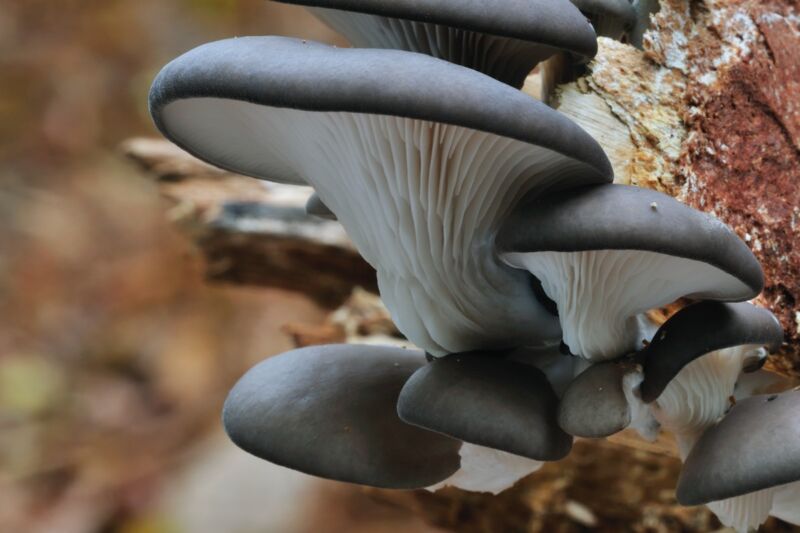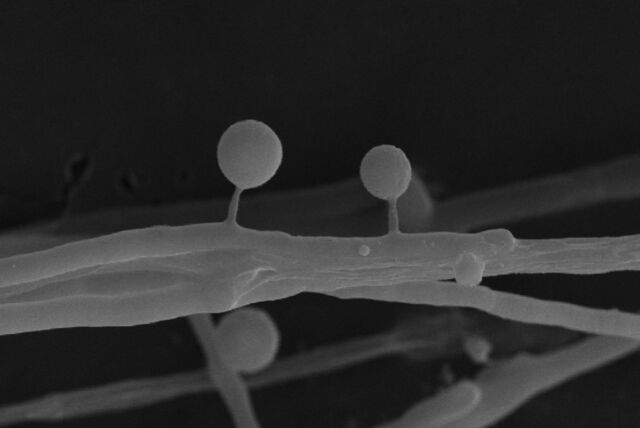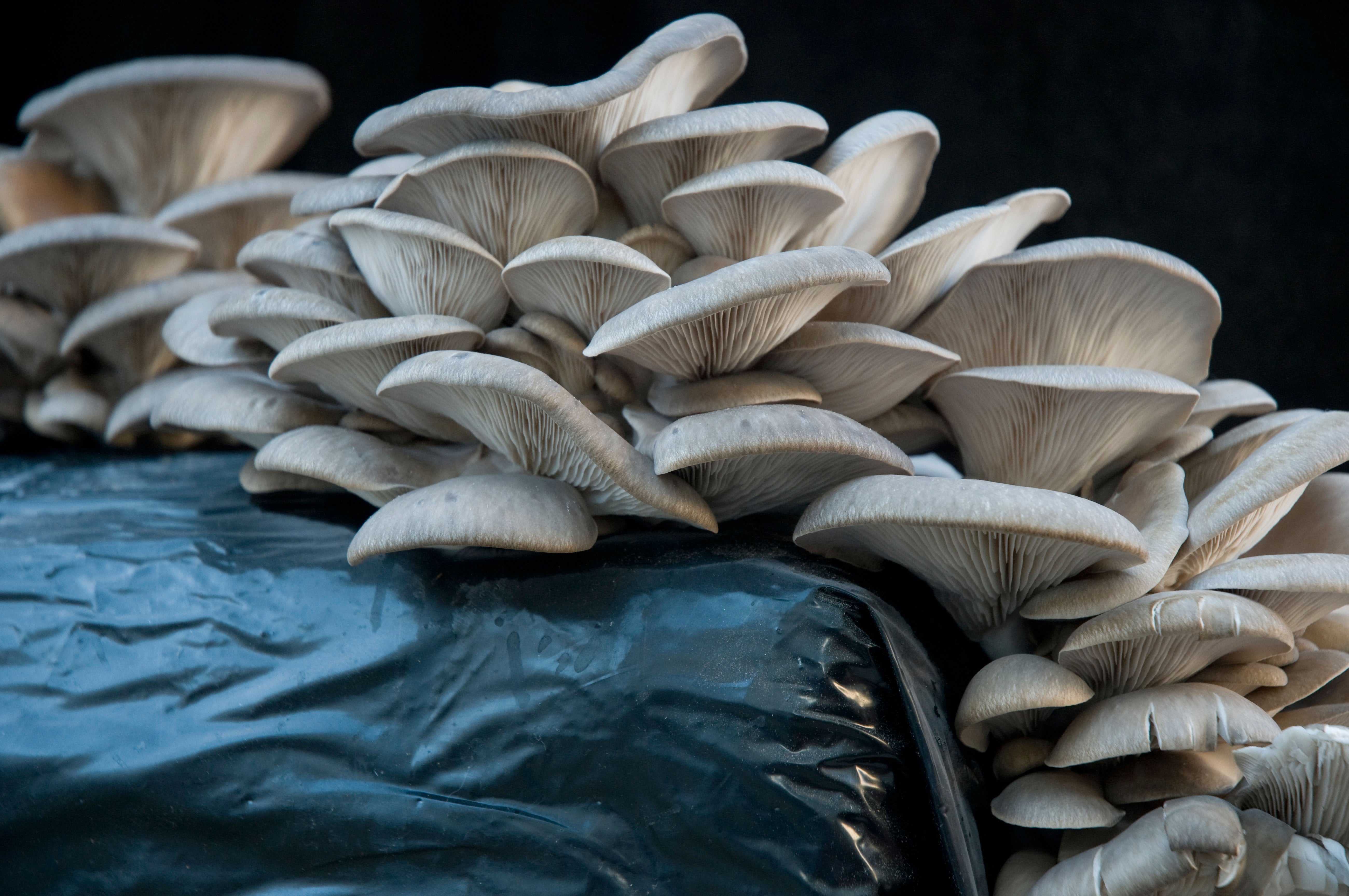
Oyster mushrooms (Pleurotus ostreatus) are a staple of many kinds of cuisine, prized for its mild flavors and a scent vaguely hinting at anise. These cream-coloured mushrooms are also one of several types of carnivorous fungi that prey on nematodes (roundworms) in particular. The mushrooms have evolved a novel mechanism for paralyzing and killing its nematode prey: a toxin contained within lollipop-like structures called toxocysts that, when emitted, causes widespread cell death in roundworms within minutes. Scientists have now identified the specific volatile organic compound responsible for this effect, according to a new paper published in the journal Science Advances.
Carnivorous fungi like the oyster mushroom feed on nematodes because these little creatures are plentiful in soil and provide a handy protein source. Different species have evolved various mechanisms for hunting and consuming their prey. For instance, oomycetes are fungus-like organisms that send out "hunter cells" to search for nematodes. Once they find them, they form cysts near the mouth or anus of the roundworms and then inject themselves into the worms to attack the internal organs. Another group of oomycetes uses cells that behave like prey-seeking harpoons, injecting the fungal spores into the worm to seal its fate.
Other fungi produce spores with irritating shapes like stickles or stilettos. The nematodes swallow the spores, which get caught in the esophagus and germinate by puncturing the worm's gut. There are sticky branch-like structures that act like superglue; death collars that detach when nematodes swim through them, injecting themselves into the worms; and a dozen or so fungal species employ snares that constrict in under a second, squeezing the nematodes to death.

The oyster mushroom eschews these physical traps in favor of a chemical mechanism. P. ostreatus is what's known as a "wood rotter" that targets dead trees, but wood is relatively poor in protein. Its long branching filaments (called hyphae) are the part of the 'shroom that grows into the rotting wood. Those hyphae are home to the toxocysts. When nematodes encounter the toxocysts, they burst, and the nematodes typically become paralyzed and die within minutes. Once the prey is dead, the hyphae grow into the nematode bodies, dissolving the contents and absorbing the slurry for the nutrients.
In 2020, a team of scientists at Academia Sinica in Taiwan tested all 15 species of P. ostreatus and found that all 15 could produce toxic drops when starved. They also tested 17 species of nematode and found that none could survive exposure to the toxin. Co-author Ching-Han Lee and colleagues suggested that the culprit might be the calcium stored in animal muscles, which, when released in response to nerve signals, causes the muscles to contract. The muscles relax when nerve signals trigger the refilling of the calcium storehouses.
To test the hypothesis, the team conducted experiments where the calcium in the worms was visible, and then tracked the response to exposure to the oyster mushroom toxocysts. They found that the pharynx and head muscles of poisoned nematodes were flooded with calcium and said calcium did not go away, leading to widespread nerve and muscle cell death. They suggested that the toxin triggers the initial calcium response, but then jams the mechanism by which the nematodes refurbish their calcium supply.
A mitochondrial calcium wave propagating throughout the hypodermis tissue after contacting P. ostreatus.Credit: Ching-Han Lee
But Lee et al. could not identify the specific toxins responsible for the effect, though they did note that the oyster mushroom's chemical mechanism was distinct from the nematicides currently used to control nematode populations. For the new study, Lee and co-authors used gas chromatography-mass spectrometry to do just that. The first version of the experiment tested a vial sample containing just the culture medium and glass beads. A second version tested a vial sample containing P. ostreatus that had been cultured for two to three weeks. The third version was a combination of the first two, testing a vial sample that contained both cultured P. ostreatus and glass beads.
The culprit: a volatile ketone called 3-octanone, one of several naturally occurring volatile organic compounds (VOCs) that fungi use for communication. It seems 3-octanone also serves as a potent nematode-killing mechanism. Exposing four species of nematode to 3-octanone triggered the telltale massive (and fatal) influx of calcium ions into nerve and muscle cells. The dosage is critical, per the authors. Low dosages are a repellant to slugs and snails, but high dosages are fatal. The same is true for nematodes. A high concentration of more than 50 percent of 3-octanone is required to trigger the rapid paralysis and widespread cell death. The team also induced thousands of random genetic mutations in the fungus. Those mutants that didn't develop toxocysts on their hyphae were no longer toxic to the nematode Caenorhabditis elegans.
As for why oyster mushrooms evolved such an unusual mechanism for killing nematodes, the authors suggest that it's because dying or rotting trees are particularly poor in nitrogen, and this mechanism is a good way for the mushrooms to make up for that deficiency. The toxocysts might even serve a defensive purpose. Specific species of nematode can pierce the fungal hyphae to suck out the cytoplasm, so having toxocysts that emit poison gas on the hyphae could protect the fungus from such predators.
DOI: Science Advances, 2023. 10.1126/sciadv.ade4809 (About DOIs).



3175x175(CURRENT).thumb.jpg.b05acc060982b36f5891ba728e6d953c.jpg)

Recommended Comments
There are no comments to display.
Join the conversation
You can post now and register later. If you have an account, sign in now to post with your account.
Note: Your post will require moderator approval before it will be visible.